Spotlight: Joseph Carini Carpets
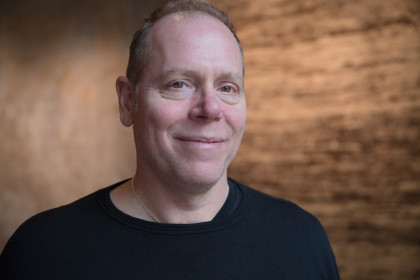 Because this site focuses on news, businesses that have been around awhile—and that make this neighborhood special—don’t get the coverage they should. The photographs are by Claudine Williams, who specializes in head shots for actors, business professionals, or anyone looking to be photographed. She also dabbles in street photography for fun. Originally from Philadelphia, she has made NYC her home for the past seven years with her husband and son.
Because this site focuses on news, businesses that have been around awhile—and that make this neighborhood special—don’t get the coverage they should. The photographs are by Claudine Williams, who specializes in head shots for actors, business professionals, or anyone looking to be photographed. She also dabbles in street photography for fun. Originally from Philadelphia, she has made NYC her home for the past seven years with her husband and son.
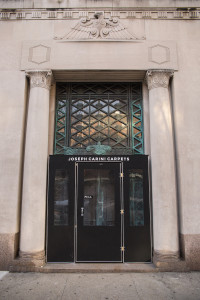 “If you get interested in a thing, you can get obsessed very quickly,” says Joe Carini (above), founder of Joseph Carini Carpets, formerly known as Carini Lang, which has been in Tribeca for more than 15 years. His obsessiveness is what makes his carpets so precious: “The color and material and care it’s made with—the conditions it’s made under—that’s its history, and that’s what you’re buying.”
“If you get interested in a thing, you can get obsessed very quickly,” says Joe Carini (above), founder of Joseph Carini Carpets, formerly known as Carini Lang, which has been in Tribeca for more than 15 years. His obsessiveness is what makes his carpets so precious: “The color and material and care it’s made with—the conditions it’s made under—that’s its history, and that’s what you’re buying.”
How did you get started in this business?
When I was a young guy, I started dealing in art. I’d spend a lot of time at action houses, and I began buying old carpets. I studied them, and I really got the bug. I became an expert in collectible carpets. In 1990, I was hired by a woman starting a new carpet company. The designs were not interesting, but the materials were. I was with her for six or seven years; I did a lot of design work for her. Then I started my own company, Carini Lang, in 1999.
 When did you open this store? Why here?
When did you open this store? Why here?
I knew the neighborhood from growing up in Manhattan. I looked uptown, but I felt that I wanted to be away from everybody. It was like something was calling me to this area. It was so counterintuitive to be down here—in fact, it still is. Our first showroom was down the street at 18 Jay, but we outgrew it after three years. This space [at Greenwich and Jay] had actually been Thierry Despont’s—I used to come here in the early 90s, and when I’d leave, I’d have to arrange a car. There was nothing around! The space had been empty for a couple of years. I knew people who lived in the building, and they said they were looking for a tenant. I got it around 2003 or 2004.
Why the recent name change?
When I started the company, I told my wife that anything I started, I wanted her name on it. And I liked the sound of the names together. When we amicably split, I bought out her shares, and she said she thought I should put my name on the company. At first, I resisted, but I’m trying to go into some new directions. It’s a new time. The old name was so abstract, and I am the owner and creative director. This reflects that.
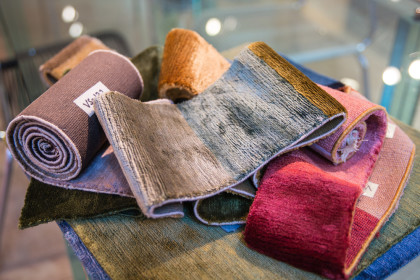 What is Joseph Carini Carpets known for?
What is Joseph Carini Carpets known for?
Doing revival work and using unusual materials, with everything hand-processed. I probably make some of the best natural dyes in the world today. I spent years trying to revive lost colors from nature. I revived colors from 200 to 300 years ago. We only knew how to make them in theory. We’re always trying to push into new areas but with ancient techniques, whether the designs are from my own art or collaborations with other artists. We have four designs by designer Alessandro Mendini launching in spring, probably at the Milan Furniture Fair. And Ashley Longshore, an artist from the south, did paintings based on precious gems that I translated into carpets.
What’s the most satisfying part of what you do?
Having clients that really understand and appreciate it. That’s really gratifying. Hearing “I love what you do” never gets old.
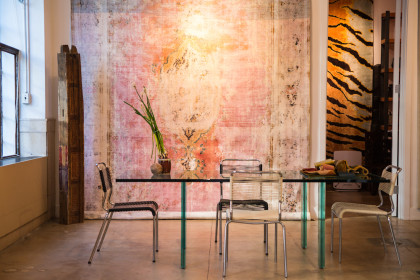 Most popular item?
Most popular item?
Organic designs based on patterns in nature. Some of those are very popular. We have a series based on the underwater world—coral, sand, and so on—that has been popular for the last eight or nine years.
Most expensive?
Material like silk and cashmere that’s been very finely woven—the labor involved is what makes it precious. I’ve made people rugs for $200,000, but for a living room rug the average is more like $15,000.
Least expensive?
We make some casual, simple room-size carpets for $5,000 to $6,000.
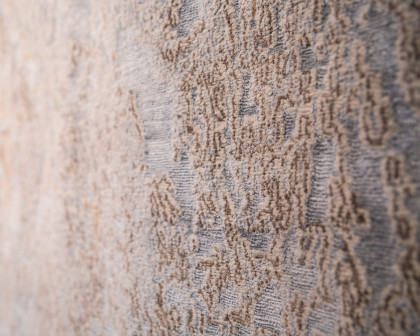 Your very favorite carpet right now?
Your very favorite carpet right now?
[Reaches for a swatch.] Like this, but in gold. It’s a superfine silk rug with natural dye. It’s kind of a tawny gold. Everybody was attracted to it. Sometimes I’m drawn to the simplest designs, and I’m often drawn to colors. Natural dyes have a different vibration than synthetic ones, and when color has a great vibration, you respond to it.
What’s the process for making a carpet?
What’s the life cycle of a carpet? After we design the carpet, maybe customizing it, we send it to Nepal (or in some cases to India), where they create the graphs, with every knot laid out. If there’s a knot there, it’s because I wanted it there—there’s no improv in this process. The materials get dyed according to what’s been ordered, then taken to a weaving hall—a big room with 10 or so looms inside. A big carpet usually takes two to three months to weave. When it’s done, it gets hand-washed with organic soap that we make. Then we ship it by air because our clients don’t tend to want to wait. It arrives here, then gets delivered. A room-size carpet takes three to four months from inception to delivery.
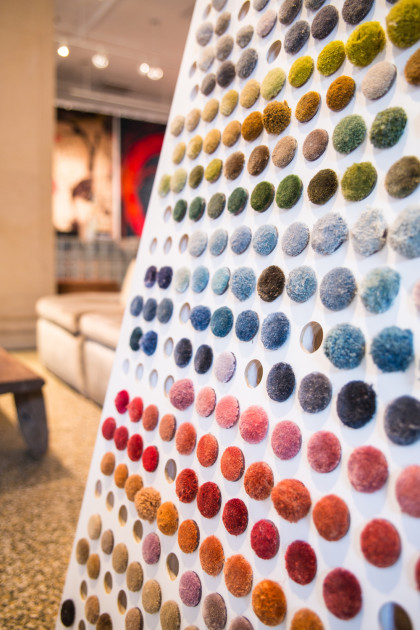 Tribeca has obviously changed a lot. Any changes that have surprised you?
Tribeca has obviously changed a lot. Any changes that have surprised you?
I was surprised when Upper East Side people started moving here in 2005 and 2006—Canal Street is no longer a barrier to people uptown. Previously, this area was only attractive to more adventurous people. I’m amazed how residential it’s become, and at the new buildings coming up. But Tribeca still has a vibe that’s different from anywhere in the city.
How has your business changed?
There’s less foot traffic even though the street is busier; in the late 90s, people would come in just to check in, say hi, see what’s going on. But we make up for it with more international business.
What percentage of your business is local?
Maybe 5 percent. Or even 3 percent.
What percentage are designers?
One hundred percent? We don’t discourage walk-ins, but even then they’re usually working with a designer.
Except during your sale….
It’s true—that’s when I see all my old friends from the neighborhood!
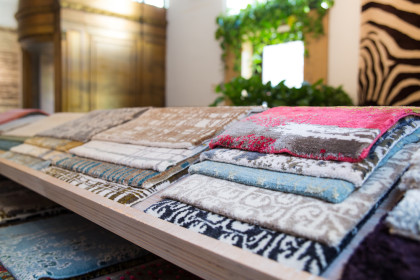 Tell me a crazy customer story.
Tell me a crazy customer story.
I was back here in the office and an employee—a young guy, well-spoken—came in stammering: “If you build it he will come is here,” he said. It was Ray Liotta! He really looks intense in person. I’m not usually starstruck but lines from Goodfellas kept running through my head and I was afraid I’d blurt one out. Usually, however, I don’t recognize people. I thought Mary-Louise Parker was just a nice young woman. Or I won’t know who they are even when they say their names.
Where do you eat/drink/shop around here?
The Odeon. ROC—Rocco and I started our businesses around the same time. Benvenuto. Sweetgreen. Juice Press. Laughing Man—I love what they do. I still like to go to Walker’s to remind myself of the old times.
What does the future hold for Joseph Carini Carpets?
I really want to continue to go into this more deeply. Keep it real, authentic, and continue traditions that are dying out. It’s so easy to sell out and go for the ABC Carpet look. I don’t mean to badmouth anyone! They do what they do well, but I think I’ll stay small and exclusive. I might open a Midtown showroom but not if I have to close this space in order to make it happen.
 Previously in this series:
Previously in this series:
••• Donzella
••• A Uno
••• Balloon Saloon
••• Fountain Pen Hospital
••• Abhaya
••• Chambers Pottery
••• Square Diner
••• Langdon Florist
••• Tribeca Upholstery & Draperies
••• Double Knot
••• Philip Williams Posters














Wonderful article! I’ve walked by it hundreds of times and peered in the windows at the beautiful carpets. Figured they all cost $50,000! Never went in!
Cool carpets (+AfroAsian sculpture collection) “Tribeca still has a vibe that’s different”. Let’s keep it that way.